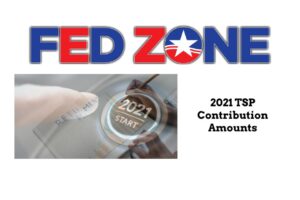Now is the Time for Employees to Choose 2021 TSP Contribution Amounts So As to Not Lose Agency TSP Matching
Edward A. Zurndorfer

Internal Revenue Code (IRC) Section 402 imposes a limit – the “elective deferral” limit – on the amount employees can contribute to their employer-sponsored defined contribution (qualified) retirement plans. These retirement plans include 401(k), 403(b), and 457 retirement plans, and the Thrift Savings Plan (TSP). This column discusses how the elective deferral limit can affect TSP agency matching contributions made to the TSP accounts of federal employees enrolled in the Federal Employee Retirement System (FERS). The column also discusses how much a FERS employee should contribute to the TSP each pay period so as to not miss out on any agency TSP matching contributions during the year.
What are “elective deferrals”?
“Elective deferrals” are amounts that an employee asks his or her employer to deduct from the employee’s salary and contribute directly on behalf of the employee to an employer-sponsored retirement plan. For federal employees, the employer-sponsored retirement plan is the TSP. All before-taxed contributions made to the traditional TSP and all after-taxed contributions made to the Roth TSP are considered elective deferrals.
The combined total of a federal employee’s traditional TSP contributions and Roth TSP contributions (but excluding “catch-up” contributions) (see below) cannot exceed the elective deferral limit in any year. For the year 2021, the election deferral limit is the as it was as during 2020 – $19,500.
Employee elective deferrals do not include agency automatic 1 percent of the employee’s SF 50 salary and agency matching TSP contributions that a FERS-covered employee receives. This is because any agency TSP contributions are not considered part of an employee’s salary.
What happens to an employee’s (younger than age 50) TSP contributions when the employee has reached the elective deferral limit at some time during the year?
Employees who are younger than age 50 as of the last day of the calendar year – December 31, and who reach via payroll deduction the elective deferral limit sometime before December will not be able to make any TSP contributions for the remainder of the calendar year. The TSP system will not allow any employee contribution to be processed that will cause the total amount of employee contributions (includes the total of traditional TSP and Roth TSP contributions) for the year to exceed the annual elective deferral limit.
Employees who will be at least age 50 as of Dec. 31, 2021 – that is, employees born before Jan. 1, 1972 – who are therefore eligible to make TSP “catch-up” contributions (maximum contributions $6,500 during 2021) and who reach the elective deferral limit will automatically have their contributions continue, applied toward the “catch-up” contribution limit. The year 2021 is the first year in which an employee over age 49 does not have to make a separate election to make “catch-up” contributions.
What happens to a FERS-covered employee’s agency matching contributions when the annual elective deferral has been reached?
When a FERS-covered employee has contributed to the TSP at some point during the year an amount equal to the elective deferral limit and the “catch-up” limit (if the employee will be over age 49 as of Dec. 31, 2021), agency matching TSP contributions will be suspended. This is because agency matching contributions are based on the amount of employee contributions that an employee makes each pay period. In other words, if there are no employee contributions in a pay period, there can be no agency TSP matching contributions.
FERS employees therefore need to keep the annual elective deferral limit in mind when deciding how much to contribute to their TSP accounts each pay period. Employees over age 49 should also keep the catch-up limit in mind as well. By reaching the elective deferral limit (and the “catch-up” limit for employees over age 49) before the last pay period of the year, an employee could lose some of the agency TSP matching contributions.
FERS employees who reach their annual contribution limit before the end of the last pay period of the year will continue to receive agency automatic (1 percent of SF 50 salary) contributions through the last pay period.
How FERS-covered employee can receive maximum agency matching 2021 TSP Contribution Amounts
To receive the matching agency matching TSP contributions, a FERS-covered employee must contribute at least five (5) percent of the basic pay the employee earns each pay period but not an amount that will result in lost agency matching contributions. The following worksheets – one worksheet for FERS-covered employees born after Dec. 31, 1971 and one worksheet for FERS-covered employees born before Jan. 1, 1972, will allow an employee to calculate how much the employee can contribute each pay period so that the employee’s contributions are spaced over the calendar year 2021, and not lose any agency TSP matching contributions.
TSP Contribution Worksheet 1: For FERS-covered employees born after December 31, 1971
| Example | Your Estimate | |
| 1. Enter the elective deferral limit for 2021 | $19,500 | $___________ |
| 2. Enter all elective deferrals made in 2021 prior to the effective date of your new election | $0.00 | $___________ |
| 3.Subtract Line 2 from Line 1 | $19,500 | $___________ |
| 4. Enter the number of salary payments you will receive in 2021 from which your new election will be deducted | 26* | $___________ |
| 5. Divide Line 3 by Line 4 – your bi-weekly TSP contribution | $750.00 | $___________ |
*Employees should check with their payroll processing offices to confirm the number of payments
For more information, employees should read the TSP Fact Sheet: Annual Limit on Elective Deferrals, downloadable here.
TSP Contribution Worksheet 2: For FERS-covered employees born before January 1, 1972
| Example | Your Estimate | |
| 1.Enter the combined elective deferral limit and catch-up limit for 2021 | $26,000 | $___________ |
| 2.Enter all elective deferrals made in 2021 prior to the effective date of your new election | $0.00 | $___________ |
| 3.Subtract Line 2 from Line 1 | $26,000 | $___________ |
| 4.Enter the number of salary payments you will receive in 2021 from which your new election will be deducted | 26* | $___________ |
| 5.Divide Line 3 by Line 4 – your biweekly TSP contribution | $1,000.00 | $___________ |
*Employees should check with their payroll offices to confirm the number of payments
For more information, employees should read the TSP Fact Sheet: Annual Limit on Elective Deferrals, downloadable here.
You Might Also Enjoy This Podcast
Edward A. Zurndorfer is a CERTIFIED FINANCIAL PLANNER™ professional, Chartered Life Underwriter, Chartered Financial Consultant, Chartered Federal Employee Benefits Consultant, Certified Employees Benefits Specialist and IRS Enrolled Agent in Silver Spring, MD. Tax planning, Federal employee benefits, retirement and insurance consulting services offered through EZ Accounting and Financial Services, and EZ Federal Benefits Seminars, located at 833 Bromley Street – Suite A, Silver Spring, MD 20902-3019 and telephone number 301-681-1652. Raymond James is not affiliated with and does not endorse the opinions or services of Edward A. Zurndorfer or EZ Accounting and Financial Services. The information has been obtained from sources considered to be reliable, but we do not guarantee that the foregoing material is accurate or complete. While we are familiar with the tax provisions of the issues presented herein, as Financial Advisors of RJFS, we are not qualified to render advice on tax or legal matters. You should discuss tax or legal matters with the appropriate professional.

2021 TSP Contribution Amounts
